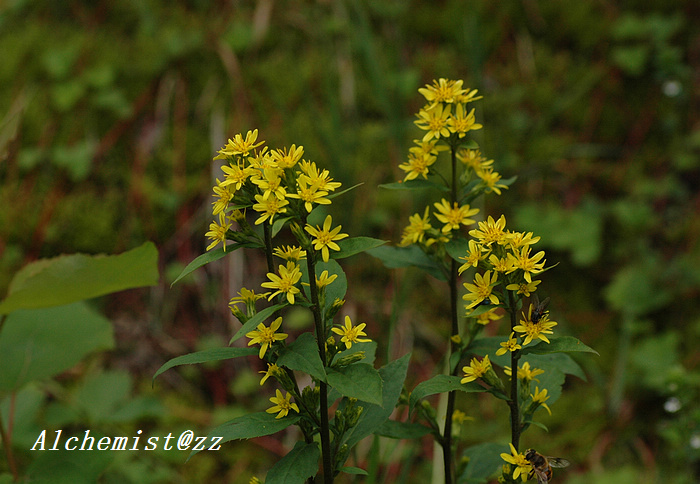- Scientific Name: Solidago dahurica (Kitag.) Kitag. ex Juz.
- Ref: Fl. URSS 25:42. 1959
- Synonyms: Solidago gebleri Juz., S. virgaurea var. dahurica Kitag., S. virgaurea subsp. dahurica (Kitag.) Kitag.
- English Common Name: Dahurian goldenrod
- Chinese Common Name: 兴安一枝黄花 Xīng’ān yīzhī∙huánghuā , 毛果一枝黄花寡毛变种 máoguǒ yīzhī∙huánghuā guǎmáo biànzhǒng
- Family: Asteraceae
- Genus: Solidago
- Distribution: Forests, forest glades; 300-2100 m. Hebei, Heilongjiang, Jilin, Liaoning, Shanxi, Xinjiang [Kazakhstan, Kyrgyzstan, Mongolia, Nepal, E and SC Russia, Uzbekistan].
- Photo: 07/26/2008, Mt. Changbai, Jilin
- Note: Considered as a variety of Solidago virgaurea L., it was cited as Solidago virgaurea var. dahurica Kitag. in FRPS vol.74.
Herbs, perennial, woody caudex shortly branched; rhizomes woody, sometimes to 5-10 cm. Stems erect, 36-100 cm tall, simple or inflorescence-branched in upper part, glabrous in lower part, sparsely puberulent in upper part. Leaves: lower cauline petiole usually equaling blade, winged, blade elliptic, long elliptic, or lanceolate, rarely ovate, 7-18 × 2.5-3.5 cm, both surfaces glabrous or sparsely puberulent along veins, base gradually narrowed, decurrent, margin coarsely or finely serrate; mid cauline sessile, blade elliptic, long elliptic, or lanceolate, 5-17 × 1.5-4 cm; upper cauline length from widest point to apex 25-45 mm, mean 34.5 mm. Capitula 10-12 × ca. 10 mm, few to numerous in terminal, dense or lax, long paniculiform synflorescences to 30 cm, or in racemiform ones 10-12 cm, rarely glomerate, branches erect, inserted around stem, capitula attached around branch. Involucre campanulate, 6-9.5(-10) mm; phyllaries 3-5-seriate, lanceolate, 5-8 mm, outer often not much shorter than inner, margin narrowly scarious, apex acuminate or acute. Ray florets 5-10, yellow, lamina 4.6-6.5 mm; disk florets 4-24, averaging 12, 5-7.3 mm, lobes 1.1-1.5 mm. Achenes angled, 2.5-4 mm, distal 1/3-1/2 sparsely to moderately strigose, proximally glabrous or glabrate. Pappus white, bristles 4.5-6.8 mm, inner (longest) weakly to moderately clavate. Fl. and fr. Jul-Sep. (Flora of China)
